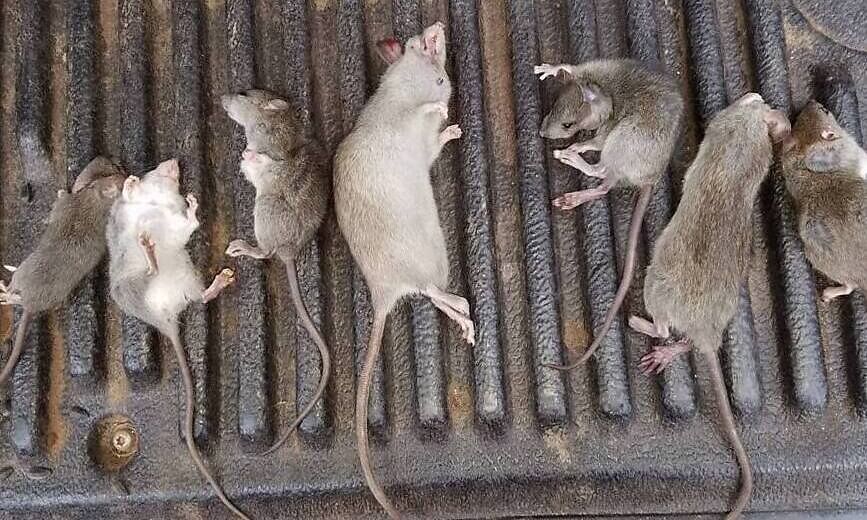How to Find Poisoned Mice

A poisoned mouse can die anywhere, at any time, for a wide number of reasons. Alternatively, it might not die at all. In reality, the latter is actually the better choice for you — the homeowner — because it means you won’t be left with the problem of hidden, decomposing mouse bodies all over your home.
If you’re using poison to kill mice in your home, stop, immediately.
Change to traditional snap traps, or call in rodent control specialists.
Poisoning mice doesn’t work to mouse-proof your home.
Poison can take many days, weeks, or even months before it offers any effects to the rodents, and that’s assuming that the rodents even eat as much of the poison as they need to in order to reap those effects. If a rodent eats a small amount and then moves on, never eating from it again, it’s likely that the mouse will escape relatively unharmed. That’s why poison is made to smell and taste pleasing to the critters, encouraging them to come and take a closer look and eat more and more.
If a mouse does consume enough of the rodenticide for it to make it sick and then die, there is likely to be a chain of events happening over a couple of days or weeks to make that happen. In some instances, the poison doesn’t actually harm the mouse enough to cause its death, instead weakening the animal and making it more vulnerable to predatory attacks. This predatory attack could be something as simple and unassuming as a run-in with a domesticated house cat. In most previous scenarios where cat comes up against mouse, the mouse has got enough of its wits about it to be able to get away fast enough. A mouse that has been maimed or made to feel unwell because of poison will not have those same wits, and this makes it more likely to die in situations it would usually survive.
If you’re lucky, your cat will bring you that poisoned mouse, leaving it at your feet like some sort of weird and bizarre gift.
Unfortunately, that exact situation could lead to secondary poisoning for your cat. If the cat consumes enough of the poisoned flesh of the mouse, it can suffer the effects of that poison. The more poison the mouse eats, the more poison can be passed on to whatever animal then feasts on it.
You don’t want your cat, dog, or other animal in the home to find a poisoned mouse to avoid secondary poisoning, and for the same reason, it’s wise to ensure that your children and potentially dangerous mice don’t come together.
A mouse that feels unwell will do what a human does when it feels unwell — it will head to bed, curl up, and sleep. Finding the nest is a good place to start when you need to look for poisoned mice, but doesn’t guarantee that you will find every carcass.
Your very own sense of smell is the best thing you can use to try and find dead/poisoned mice, and the more decomposed the carcass, the more of a bad stench it will kick up. Move around your home, smelling every room. Where the bad smell is most concentrated, the closer you are to the root cause of that smell.
Dead mice can end up anywhere, and especially in all the places that you can’t easily get to. This includes in crawl spaces, under floorboards, in wall cavities, and in the attic. Dead rodents are commonly found in pipes, ducts, and vents, and it is also not unusual to find them under furniture and even appliances, such as those in the kitchen. Moving those appliances and items of furniture every now and again will shake up any rodents that are hiding under there, and will also unearth any carcasses. Sadly, you can’t perform the same activity to check crawl spaces or wall cavities.
If you suspect that a rodent has died beneath one of the walls in your home, there are three things that you can try to do to access it and then retrieve it. You could try heading up into the attic to see if you can see down into that wall cavities from above. If you can, you can use something to help retrieve the dead mouse/mice, and any other material that could be contaminated. If you can’t, you could try the same approach, but from the bottom. If you head into the basement, can you see up into any areas of the house, such as inside the walls? It is unlike that you will be able to, but you must try everything else before you finally resort to option number three ... Actually cutting out a chunk of your wall.
In some cases, the only way to access a decomposing body of a mouse in the wall cavity is to cut out an actual section of that wall, remove the offensive item, and then patch the wall back up again. You will want to know EXACTLY where the carcass is before you take this action, or you’ll have multiple holes in walls that you’ll then need to repair. If you can’t be sure where the carcass is, taking a step back and calling in the professionals might be a better route to take. Rodent control specialists are experts in not just removing live mice, but also dead mice too.
